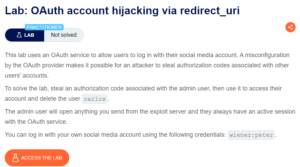OAuth account hijacking via redirect_uri

Descripción This lab uses an OAuth service to allow users to log in with their social media account. A misconfiguration by the OAuth provider makes it possible for an attacker to steal authorization codes associated with other users’ accounts. To solve the lab, steal an authorization code associated with the admin user, then use it […]